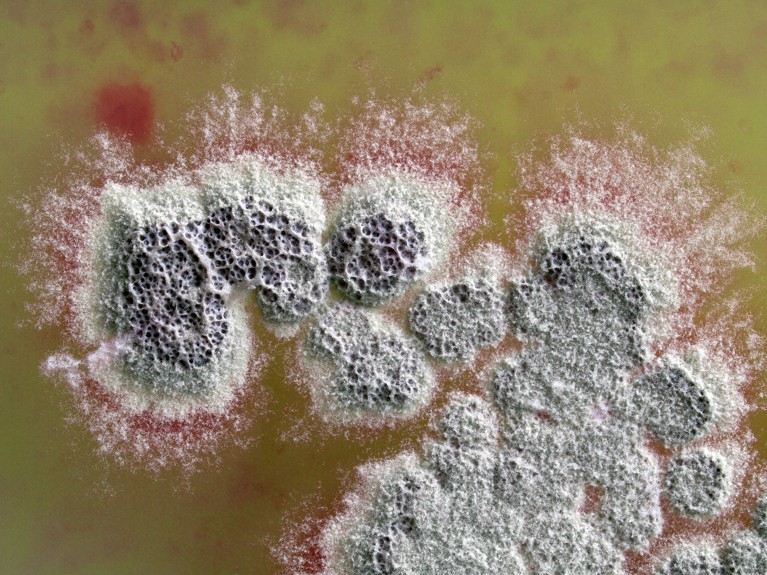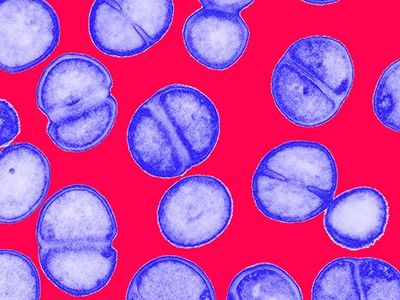
A colony of Streptomyces coelicolor micro organism secretes an antibiotic compound (purple) into the encompassing medium.Credit score: Dr Jeremy Burgess/Science Picture Library
By learning the method by means of which a soil bacterium naturally produces a well known drug, scientists have found a robust antibiotic that would assist to struggle drug-resistant infections.
In experiments described within the Journal of the American Chemical Society on Monday1, the staff studied the multi-step pathway that the bacterium Streptomyces coelicolor makes use of to make the antibiotic methylenomycin A, which was first recognized in 19652,3. They found an intermediate compound — referred to as premethylenomycin C lactone — whose antimicrobial exercise was 100 instances stronger than that of the ultimate product. Tiny doses of it killed strains of micro organism identified to trigger hard-to-treat infections.
5 methods science is tackling the antibiotic resistance disaster
The invention was a ‘shock’, says research co-author Gregory Challis, a chemical biologist on the College of Warwick in Coventry, UK. “As people, we anticipate that evolution perfects the top product, and so that you’d count on the ultimate molecule to be the very best antibiotic, and the intermediates to be much less potent,” he says. However the discovering “is a good instance of what a ‘blind watchmaker’ evolution is. And it’s a great way of exemplifying it in a really molecular method,” provides Challis.
Antimicrobial resistance is a rising menace, projected to trigger 39 million deaths worldwide over the following 25 years. Researchers say that the invention of a potent antimicrobial compound may result in recent medicine to deal with resistance.
The work underscores “the potential of such research to establish new bioactive chemical scaffolds from ‘outdated’ pathways”, says Gerard Wright, a biochemist at McMaster College in Hamilton, Canada.
Unintentional discovery
In 2006, Challis and his colleagues started learning the molecular pathway by means of which Streptomyces coelicolor produces methylenomycin A. To do that, they deleted the genes encoding enzymes concerned in every step, one after the other. Their work constructed on earlier efforts in 2002 to sequence the bacterium’s genome4.
New antibiotic that kills drug-resistant micro organism found in technician’s backyard
By 2010, the staff had mapped the mechanism that the bacterium used to make methylenomycin A and recognized a number of intermediate molecules that it produced alongside the best way.
“We have been simply doing very basic blue-sky analysis,” says Challis. “We found these intermediates, and we left them for some time as a result of we didn’t fairly know what to do with them.”
It was a number of years later — round 2017 — {that a} PhD pupil at Challis’s laboratory examined these intermediate molecules for antimicrobial exercise.
These assessments revealed that two molecules, together with premethylenomycin C lactone, have been far more efficient than methylenomycin A at focusing on seven strains of Gram-positive micro organism, together with Staphylococcus aureus, which infects pores and skin, blood and inner organs, and Enterococcus faecium, which might trigger lethal bloodstream and urinary infections.
The bottom focus of premethylenomycin C lactone wanted to kill drug-resistant strains of Staphylococcus aureus was simply 1 microgram per millilitre, in contrast with 256 micrograms per millilitre of methylenomycin A. The compound might additionally kill micro organism at a lot smaller doses than these wanted for vancomycin, a ‘final line’ antibiotic used to deal with infections attributable to two Enterococcus faecium strains, to be efficient.

